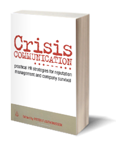A new white paper out today by Cision has a simple but powerful message for PR professionals.
There are the generic top 5 peeves that all journalists around the globe seem to have:
(1) Sending generic mass email blasts to journalists;
(2) Ignoring what the journalists or outlets actually cover;
(3) Making unnecessary follow-up phone calls;
(4) Pitching identical stories to competing outlets; and
(5) Not taking “no” for an answer.
Getting over these are relatively simple...
1. Keep it personal
Know the person you’re talking to. Research your target contacts in advance and personalize your communication. Never send a mass e-mail with zero familiarity about the recipient. Journalists who take emailed story ideas want proposals tailored to
them personally. Nothing is more impressive than proving you know someone’s history; at the same time, nothing is less impressive than sending out a blanket press release with no introduction.
2. Know what people cover
Nothing annoys a journalist more than receiving a pitch that clearly demonstrates no knowledge of his or her coverage area. Do your homework, offer interesting information that is relevant to the stories that journalist is working on, and you are more likely to be rewarded with a return call.
3. Be helpful – not a pest
Don’t follow up an email with a phone call. With many journalists’ inboxes overflowing with week-old, unread messages, they commonly complain about being “badgered” by multiple phone calls shortly after getting an email. The best rule of thumb is: If you hear back from a reporter, editor or blogger, he or she is interested; if not, move
on.
4. Be transparent about story exclusivity
Don’t pitch an exclusive story idea to multiple competitors. Let a contact know whether you’re proposing an exclusive story or if the story is being shopped around to various contacts. It’s a good way to maintain transparency and spark interest. Journalists are competitive and a story is more likely to get traction if a journalist knows it’s a scoop.
5. Develop a thick skin if your proposal is rejected or ignored
Not every pitch will get used, but journalists often keep valuable PR contacts on file. Remember that developing a relationship with a reporter, editor or blogger is the best way to score coverage, and it usually takes time to develop these relationships and build trust.
So simple, but still ignored every day.
Do we agree at NettResults with the above points? Mostly...
It is all about relationships. There is no doubt about that. But the "don't call after an email or you'll be a pest"? If you have a good relationship with the media, and call a journalist you know well for a number of things (not just to follow up with a 'did you get my email') then the fine line of 'pest' turns into a 'friendly chat' - and who doesn't like a friendly chat?
Of course the alternative is to just do everything on email and never call a journalist. But how does that develop a relationship?
Note to any client - if you walk into your PR agency and it sounds like the Mary Celeste with perhaps only the sound of finger hitting keyboard, you need to check the validity of your agency's media contacts.
Subscribe to:
Posts (Atom)

